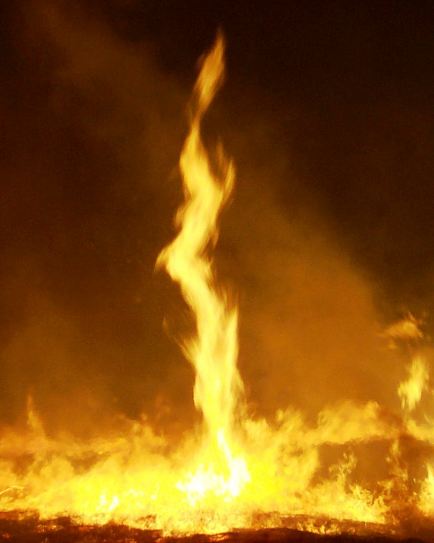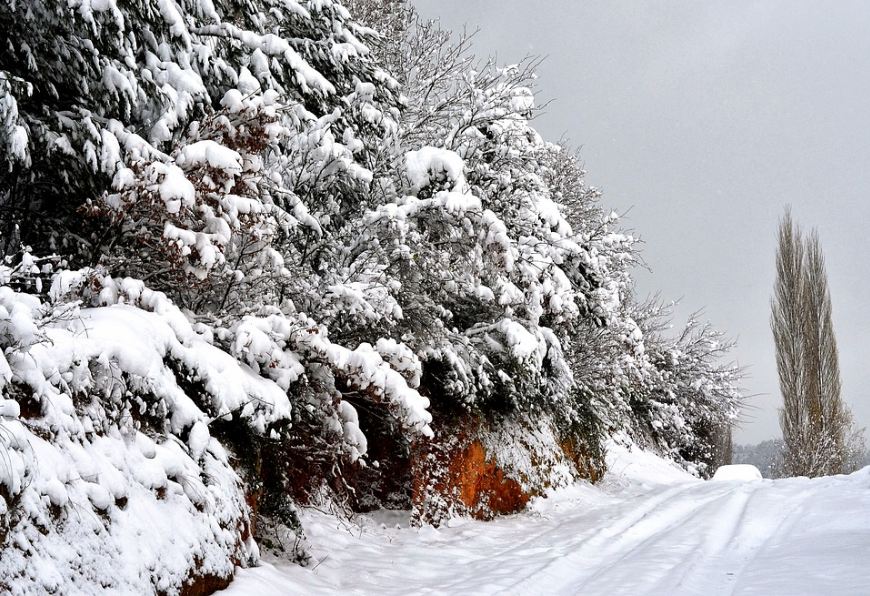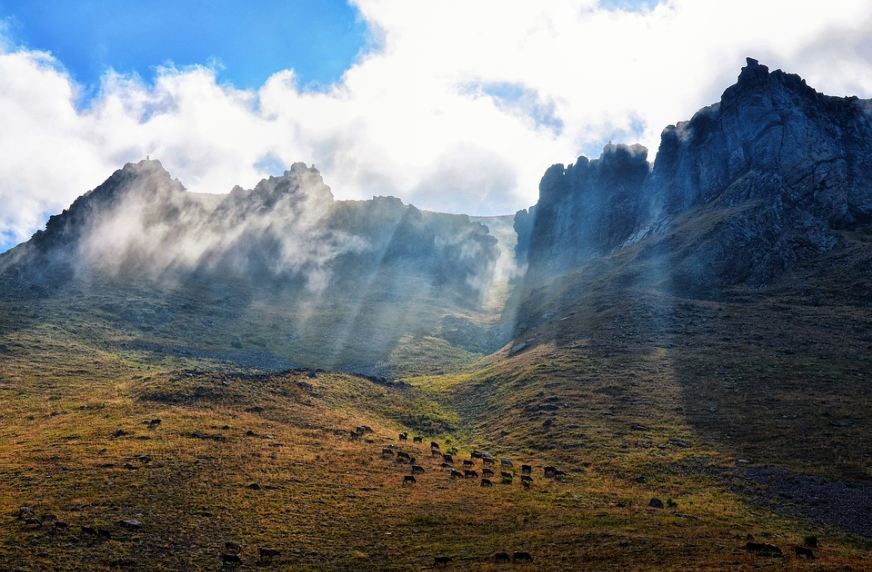Why Do Atmospheric Rivers Alter Weather Patterns?

Atmospheric rivers, those massive moisture-laden air streams, can transform weather by transporting vast amounts of water vapor from tropical regions to mid-latitudes. When they hit land, they release this moisture as heavy rain or snow, greatly affecting precipitation patterns. This can lead to severe flooding, especially if multiple atmospheric rivers follow one another. Global warming makes these events stronger and more frequent, impacting local climates and water supplies. You'll find that understanding their full impact on the environment and economy gets even more fascinating.
Key Takeaways
- Atmospheric rivers transport immense water vapor, contributing significantly to precipitation and altering local weather patterns.
- Their high moisture content leads to intense rainfall and snow, impacting regional climate conditions.
- Interaction with atmospheric circulation patterns influences their size, intensity, and direction, altering weather systems.
- Consecutive atmospheric rivers saturate soil, increasing runoff and flood risks, drastically changing weather dynamics.
- Global warming intensifies atmospheric rivers, increasing their frequency and altering traditional weather patterns.
Definition of Atmospheric Rivers
When you hear about atmospheric rivers, think of them as narrow corridors in the sky, typically stretching 250 to 375 miles wide, that transport immense amounts of water vapor from tropical areas to mid-latitudes and even the poles. These aerial highways can extend up to 1,000 miles in length and carry as much moisture as the Amazon River. Some of the strongest atmospheric rivers transport 7 to 25 times more water than the Mississippi River.
These phenomena are vital for regions like California, where they can account for 30-50% of the annual precipitation. When atmospheric rivers make landfall, they release their moisture, greatly impacting local weather patterns. While they are fundamental for replenishing water supplies and supporting ecosystems, they can also lead to severe flooding and mudslides. This dual nature makes them both beneficial and potentially hazardous.
Warm tropical oceans, where the air can hold more moisture, are the primary birthplaces of atmospheric rivers. When these moisture-laden corridors hit land, especially in regions like California, they can cause dramatic weather events, altering familiar patterns and sometimes leading to disaster.
Formation and Characteristics
Atmospheric rivers, fascinating yet complex weather phenomena, typically form over warm tropical oceans where high temperatures lead to a considerable concentration of moisture. These systems are like massive conveyor belts, transporting water vapor towards mid-latitude regions where they can greatly impact weather patterns.
- Spanning 250 to 375 miles in width
- Reaching lengths up to 1,000 miles
- Transporting about 10.5 trillion gallons of water daily
When atmospheric rivers travel, they carry immense amounts of moisture in the atmosphere. Envision this: the average atmospheric river can transport as much water vapor as the flow of the Mississippi River every day! As these rivers of vapor approach land, especially mountainous terrain, the moisture cools and condenses, leading to heavy precipitation. This can result in extreme weather events, making them critical climate phenomena to understand.
Atmospheric circulation patterns play a huge role in altering the size, intensity, and direction of these atmospheric rivers. These changes can greatly affect local weather conditions, making atmospheric rivers a key factor in predicting and understanding weather patterns. Their ability to transport considerable moisture concentration makes them both a marvel and a menace in meteorology.
Role in Precipitation

Ever wondered how much of your local rainfall is influenced by atmospheric rivers? These powerful weather phenomena can contribute over 50% of the annual precipitation in coastal regions, particularly along the U.S. West Coast. Atmospheric rivers transport immense amounts of water vapor, often equating to the flow of the Mississippi River. When they make landfall, the moisture within these rivers cools and condenses, resulting in intense rainfall and snow, especially in mountainous areas.
The precipitation brought by atmospheric rivers plays a vital role in your local water supply. They can replenish reservoirs and aquifers, ensuring that there's enough water for different needs. However, the variability in the size, strength, and movement of atmospheric rivers means they can also lead to severe flooding events.
When multiple atmospheric rivers, known as AR families, occur consecutively, they can greatly heighten flood risks. The ground becomes saturated, leading to increased runoff and potential flooding. Despite the flood risks, the beneficial rainfall from atmospheric rivers remains fundamental for maintaining a stable water supply. Therefore, atmospheric rivers are a double-edged sword, providing necessary moisture while also posing challenges with precipitation and flood management.
Flood Risks From AR Families
The threat of flooding escalates greatly when consecutive atmospheric rivers, known as AR families, hit an area. These sequential storms can lead to extreme flood risks due to their pattern of delivering heavy rainfall over short periods. At the outset, the heavy rainfall from the initial atmospheric river saturates the soil, making the area highly vulnerable to flooding from any subsequent storms within the same AR family.
You should be aware of the following key points about AR families and their impact:
- Increased flood risks: With each storm, soil saturation worsens, and runoff intensifies, markedly increasing the likelihood of flooding.
- Economic damage: AR families can cause three to four times more economic damage compared to single atmospheric river events.
- Intense precipitation events: Climate phenomena like the Madden-Julian Oscillation can amplify the frequency and intensity of these precipitation events.
An example of this heightened flood risk was observed in California from December 2022 to January 2023, when nine back-to-back atmospheric rivers wreaked havoc. These AR families don't just bring immediate flood dangers; they also create long-lasting economic damage by destroying infrastructure, homes, and farmlands. Understanding and preparing for these events can mitigate some of the severe flood risks associated with AR families.
Impact on Water Supply
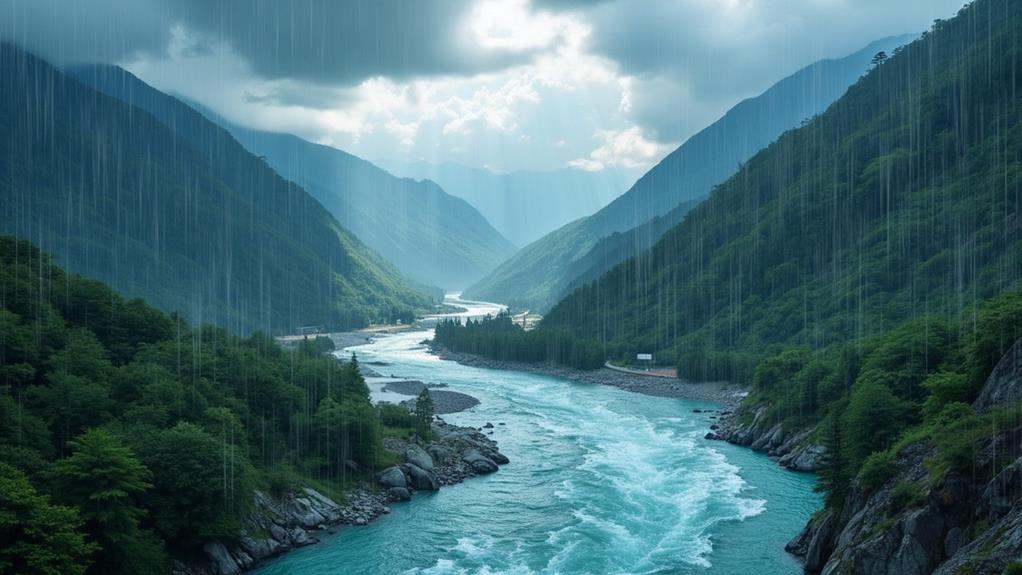
While the dangers of flooding from AR families are alarming, it's also important to recognize their considerable impact on water supply. Atmospheric rivers account for 30-50% of the annual precipitation on the U.S. West Coast, playing a key role in replenishing local water resources. These weather systems draw moisture from the tropics and deliver extreme rainfall, which is necessary for filling reservoirs and maintaining California's water resources.
One or two extreme atmospheric rivers can dramatically enhance annual snow accumulation in the Sierra Nevada. For instance, record snowfall in early 2023 led to Lake Oroville reaching 100% capacity. This snowpack acts as a natural reservoir, slowly melting to provide a sustained water supply throughout the year, vital for agriculture and ecosystems.
Atmospheric rivers also have the power to end drought conditions by delivering large volumes of moisture quickly. This sudden influx can considerably alter water availability, impacting everything from drinking water to crop irrigation. Improved forecasting of atmospheric rivers is crucial for effective water management and flood risk mitigation. By predicting these events accurately, communities can better prepare and adapt to changes in their water supply, ensuring a more resilient future.
Effects of Global Warming
Global warming's impact on atmospheric rivers is significant and multifaceted. As the planet warms, the air can hold more moisture—up to 7% more for every 1°C increase. This improved moisture capacity leads to more intense atmospheric rivers, which can result in extreme precipitation events. Climate change isn't just fluctuating temperatures; it's reshaping our weather patterns.
- Increased moisture capacity: Warmer air holds more water, leading to more intense precipitation.
- More frequent events: Studies show that atmospheric rivers are occurring more often due to global warming.
- Augmented by climate phenomena: Events like El Niño, influenced by climate change, can make atmospheric rivers more persistent.
The Clausius-Clapeyron relationship explains why more moisture in the atmosphere correlates with an observed rise in extreme precipitation events. This means you can expect heavier rainfall during these events, which poses significant challenges for water management. Regions like California may face greater variability in annual precipitation, complicating efforts to adapt to these changes. As intense atmospheric rivers become more common, preparing for extreme weather and managing water resources effectively will be vital. Global warming is altering our environment in ways that demand urgent attention and action.
Influence on Local Climates

As global warming intensifies atmospheric rivers, these phenomena are reshaping local climates in profound ways. You'll notice that atmospheric rivers can account for over half of the annual precipitation in coastal regions. This influx of precipitation greatly impacts local climates by replenishing water supplies, which is essential for agriculture and comprehensive water resources.
When atmospheric rivers sweep through, they often bring increased rainfall and snow accumulation. In places like California's Sierra Nevada, the snowpack formed from these events is critical for maintaining water resources throughout the year. However, this also means local climates can experience drastic shifts during atmospheric river events. Heavy precipitation can lead to flooding, mudslides, and altered ecosystems, pushing local climates to their extremes.
Moreover, atmospheric rivers often improve storm systems, providing the moisture that fuels extreme weather events. An example is the Pineapple Express, which delivers tropical moisture to the U.S. West Coast, causing substantial rainfall. The variability in size and intensity of these atmospheric rivers results in fluctuating precipitation patterns, influencing drought conditions and affecting total climate stability in the regions they impact. Consequently, you can see how atmospheric rivers play a pivotal role in shaping local climates.
Economic and Environmental Impacts
Atmospheric rivers have far-reaching economic and environmental impacts, greatly affecting regions like the U.S. These phenomena are responsible for 30-50% of annual precipitation on the U.S. West Coast, which is vital for the region's water supply and agricultural productivity. However, the heavy precipitation associated with atmospheric rivers can also lead to severe flooding, mudslides, and property damage, posing significant risks to infrastructure and public safety.
Key impacts include:
- Increased flooding risks: Consecutive atmospheric river events, known as AR families, cause 3-4 times more economic damage than single events due to heightened flooding risks.
- Water supply benefits: In California, extreme atmospheric river events contribute to substantial snowpack replenishment in the Sierra Nevada, critical for the state's water resources.
- Climate change effects: Research indicates that climate change is projected to increase the frequency of extreme flooding events linked to atmospheric rivers, heightening year-to-year variability in precipitation patterns.
While atmospheric rivers play a vital role in replenishing snowpack and supporting water supply, their potential for causing significant economic damage and environmental disruption underscores the importance of understanding and preparing for these powerful weather events.
Mitigation and Forecasting Strategies
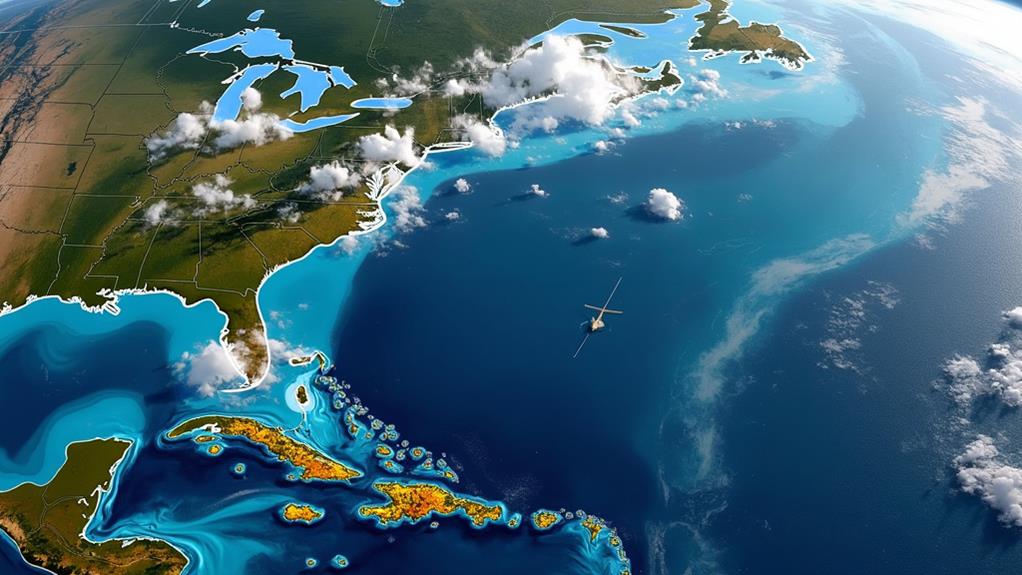
Understanding the significant economic and environmental impacts of atmospheric rivers, it's clear that effective mitigation and forecasting strategies are vital. Investing in advanced forecasting models, like the Energy Exascale Earth System Model (E3SM), can dramatically improve your ability to predict how these weather patterns will behave. With more accurate predictions, you can better prepare for the potential impacts of atmospheric rivers.
Early warning systems are also important. These systems allow meteorologists to provide timely hazard information, giving you a heads-up 5-7 days before a significant weather event. This advanced notice can make all the difference in preparing for potential flooding and other adverse effects.
Another key element is enhancing infrastructure resilience. Implementing flood control measures, such as levees and improved drainage systems, can help manage the risks associated with atmospheric rivers, thereby mitigating their impacts on your community.
Community education programs play a significant role as well. By increasing public awareness about the risks and preparedness strategies related to atmospheric rivers, you can foster a more informed and responsive community. Ongoing research, such as the ARTMIP project, continues to improve our understanding and predictions, further aiding in effective mitigation.
Frequently Asked Questions
How Do Atmospheric Rivers Affect Weather?
Atmospheric rivers impact weather by transporting massive amounts of moisture, leading to storm intensification and significant precipitation events. When these rivers stall, they increase flood risks and cause coastal impacts. They interact with mountainous terrain, enhancing rainfall or snowfall. Furthermore, atmospheric rivers play a role in climate variability and can influence drought mitigation. Their changing patterns, influenced by phenomena like El Niño, affect regional weather unpredictably.
Do Rivers Change Weather Patterns?
Rivers might not seem like they change weather patterns, but when you think of atmospheric rivers, the dynamics are different. They transport vast amounts of moisture over long distances, leading to precipitation extremes, and impacting climate variability. These storm systems improve local precipitation through orographic lift, increasing flood risk. The hydrological impact of these atmospheric phenomena is profound, reshaping weather patterns and altering regional climates considerably more than terrestrial rivers.
How Do Atmospheric Conditions Influence Weather Patterns?
You influence weather patterns through changes in air pressure, humidity levels, and temperature variations. Wind patterns shift, driving storm systems that affect precipitation rates. Climate change exacerbates these effects, altering the way moisture moves and storms develop. When air pressure drops, it can trigger storms; high humidity levels contribute to rain; and temperature variations can lead to severe weather. So, you play a vital role in shaping local and global weather.
Is an Atmospheric River Good or Bad?
Did you know atmospheric rivers can provide up to 50% of the annual precipitation on the U.S. West Coast? They have clear benefits, like drought mitigation effects and vital water supply, but the impacts of atmospheric rivers aren't always positive. Extreme precipitation events can cause floods and severe damage. Proper flood risk assessment and understanding climate change connections are critical. Their effects vary regionally, highlighting the importance of preparedness.

